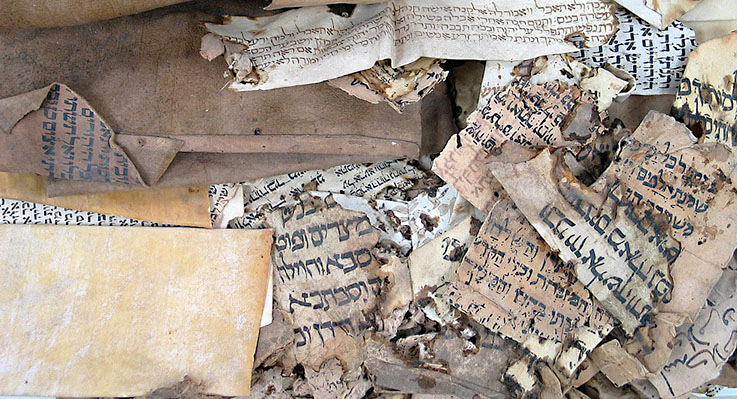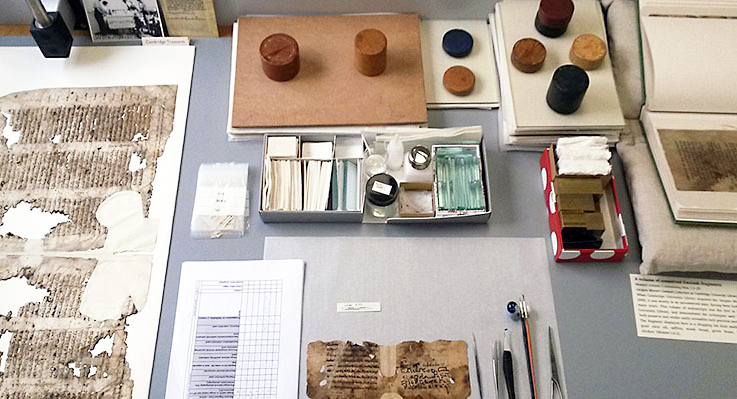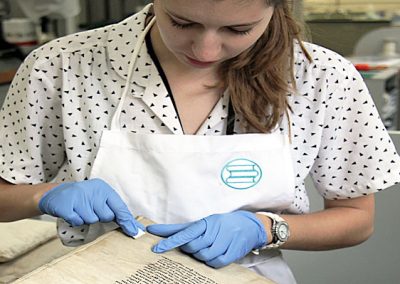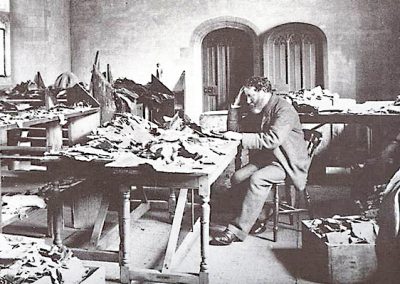
Bible, History, Archaeology
Bible,
History,
Archaeology
La Guéniza
Old Cairo, Egypt
The Aramaic term guenizah (from GNZ, «to hide», «to be precious») designates a room, adjoining the synagogue, intended to receive the manuscripts of the Law that had become unusable through the wear and tear of age or cultic manipulation: held sacred because they contained the divine name, they were to be neither destroyed nor profaned.
The Gardenizah
 The word guenizah refers to an ancient form of Jewish deposit. The word comes from ganaz, and means «treasure», «hiding place», «shelter», «archive». Applied to documents, it is equivalent to the word «burial». Any document too worn out to be of any further use was hidden away to avoid desecration, since, according to the Jews, the contents of a book go to heaven, like the soul. «I see the parchment burning, and the letters flying through the air»These were the last words of the martyred R. Hanina ben Teradyon (under Hadrian, 2nd century) as he went to the stake wrapped in scrolls of the Law. Used copies of the Pentateuch were sometimes buried in the tombs of scholars. Usually, however, the books were simply buried or deposited in a kind of lean-to next to the synagogue.
The word guenizah refers to an ancient form of Jewish deposit. The word comes from ganaz, and means «treasure», «hiding place», «shelter», «archive». Applied to documents, it is equivalent to the word «burial». Any document too worn out to be of any further use was hidden away to avoid desecration, since, according to the Jews, the contents of a book go to heaven, like the soul. «I see the parchment burning, and the letters flying through the air»These were the last words of the martyred R. Hanina ben Teradyon (under Hadrian, 2nd century) as he went to the stake wrapped in scrolls of the Law. Used copies of the Pentateuch were sometimes buried in the tombs of scholars. Usually, however, the books were simply buried or deposited in a kind of lean-to next to the synagogue.
Image opposite: fragments of various manuscripts from the Cairo guenizah before conservation and classification. University of Cambridge and Bodleian Libraries, University of Oxford.
Fortunately for scientists, these hiding places weren't just reserved for out-of-use manuscripts. Over the centuries guénizot (plural of guénizah) often housed «invalids», i.e. books with a few pages missing, as well as those «fallen from grace», i.e. books originally classified as sacred Scripture, but whose divine inspiration was later challenged. The guenizah thus served not only to protect «good books» from desecration, but also to defend the faithful against «bad books».
Other works

In Europe, many cemeteries set aside space for the burial of such texts. In the East, Muslims and Copts did the same with their sacred books: moved by a sense of respect, they buried such documents between the stones of walls, or even in an attic or tomb.
Image opposite: Lewis-Gibson curator's workbench © University of Cambridge and Bodleian Libraries, University of Oxford.
In the ancient Coptic Orthodox monastery of Sohag (south of Assiout on the left bank of the Nile), for example, also known as the Red Monastery, a special pit housed damaged prayer books, worn-out priestly vestments and obsolete objects once used in worship.

The interior of the Ben Ezra synagogue in Cairo, Egypt, after its complete restoration. The synagogue housed a Genizah, a sacred archive of some 200,000 Jewish manuscripts dating from 870 to 1880. In the foreground of the photo on the right is a catafalque which, according to tradition (legend?), contains the remains of the prophet Jeremiah, who joined the Jews fleeing the Neobabylonians (Jeremiah 43). Christian Marquant de Clio, with kind permission.
Headgear and shoe soles!
Let's mention two of the most common objects where manuscripts were often discovered: headgear and shoes. More than one manufacturer of «tarbouches» (fez, Egyptian headdress) used papyrus or sheets of paper to give his headdresses the necessary rigidity, and, without knowing it, Turks and Egyptians protected their heads for a long time with manuscripts worth a fortune. The scholars who feverishly searched tombs, convents and rubble for some rare document, had no idea that their servant or the local cafe owner might be wearing it sewn into the lining of his «tarbouche».
On the other hand, more than one shoemaker of yore «reinforced» the soles of shoes by placing a few sheets of papyrus between two pieces of leather, a process perfected by our contemporary shoemakers who use cardboard for the same purpose. This practice, cited as an example of dishonesty peculiar to our times, in fact dates back to the earliest antiquity. As far back as ancient times, unscrupulous shoemakers cheated their customers... much to the delight of modern scientists, who have more than once recovered rare manuscripts from old shoes (Grohmann, Papyri) and even more recently a papyrus fragment containing part of Mark's Gospel among the layers of an Egyptian mummy's mask dating from the end of the 1st century A.D. (Craig Evans, Professor of New Testament at Acadia Divinity College in Wolfville, Nova Scotia, Canada)!
By far the most famous of these, in terms of both the number and quality of the texts stored there, is the Old Cairo Gardenizah, discovered in 1864 by Jacob Saphir, and mainly studied by the English rabbi and academic Solomon Schechter (1875-1915).
The Lewis-Gibson team discusses a fragment. From left to right, Rebecca Goldie, Mary French and Emma Nichols © University of Cambridge and Bodleian Libraries, University of Oxford.
The Lewis-Gibson team discusses a fragment. From left to right, Rebecca Goldie, Mary French and Emma Nichols.
Collecting parchment samples for collagen analysis. University of Cambridge and Bodleian Libraries, University of Oxford.
Collecting parchment samples for collagen analysis.
Pigment analysis by X-ray fluorescence (XRF) and adhesive analysis by infrared spectroscopy (FT-IR). University of Cambridge and Bodleian Libraries, University of Oxford.
Pigment analysis by X-ray fluorescence (XRF) and adhesive analysis by infrared spectroscopy (FT-IR).

Find out more
VOLKOFF Oleg, Searching for manuscripts in Egypt
Institut Français d'Archéologie Orientale, Cairo, 1970.




